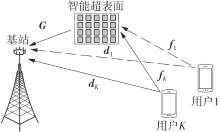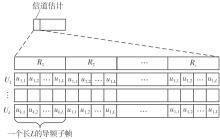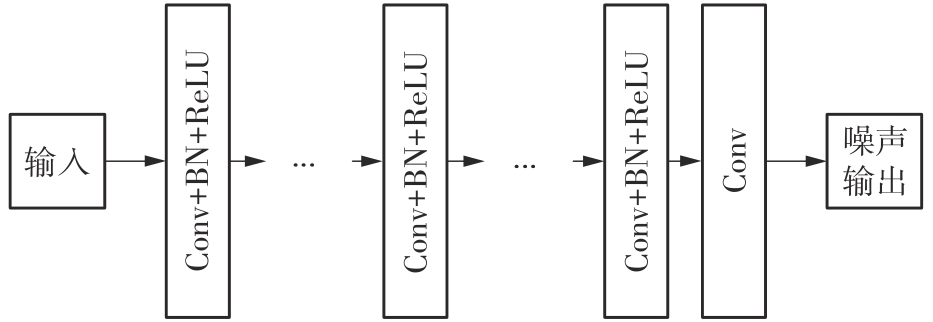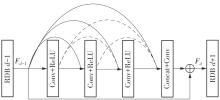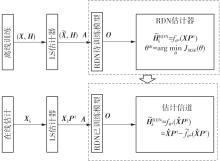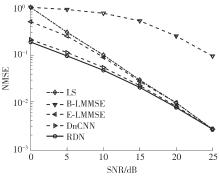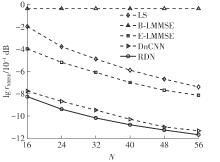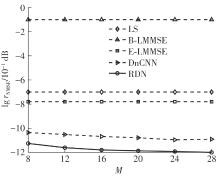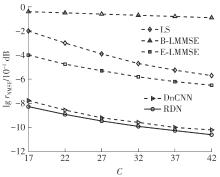Journal of South China University of Technology(Natural Science Edition) ›› 2024, Vol. 52 ›› Issue (3): 102-111.doi: 10.12141/j.issn.1000-565X.230081
• Electronics, Communication & Automation Technology • Previous Articles Next Articles
Reconfigurable Intelligence Surface Channel Estimation Algorithm Based on RDN
ZHENG Juanyi DONG Jiahao ZHANG Qingjue YANG Pujiang GUO Mengyue YANG Puzhen
- School of Communication and Information Engineering,Xi’an University of Posts and Telecommunications,Xi’an 710121,Shaanxi,China
-
Received:2023-03-03Online:2024-03-25Published:2023-07-13 -
About author:郑娟毅(1977-),女,高级工程师,主要从事无线通信研究。E-mail: zjyi@xupt.edu.cn -
Supported by:the National Natural Science Foundation of China(61901367)
CLC Number:
Cite this article
ZHENG Juanyi, DONG Jiahao, ZHANG Qingjue, et al. Reconfigurable Intelligence Surface Channel Estimation Algorithm Based on RDN[J]. Journal of South China University of Technology(Natural Science Edition), 2024, 52(3): 102-111.
share this article
| 1 | 马向进,韩家奇,乐舒瑶,等 .可重构智能超表面设计及其无线通信系统应用[J].无线电通信技术,2022,48(2):258-268. |
| MA Xiangjin, HAN Jiaqi, YUE Shuyao,et al .Reconfigurable intelligent metasurface design and applications in wireless communication systems[J].Radio Communications Technology,2022,48(2):258-268. | |
| 2 | RUAN C, ZHANG Z, JIANG H,et al .Approximate message passing for channel estimation in reconfigurable intelligent surface aided MIMO multiuser systems[J].IEEE Transactions on Communications,2022,70(8):5469-5481. |
| 3 | BJÖRNSON E, ÖZDOGAN Ö, LARSSON E G .Reconfigurable intelligent surfaces:Three myths and two critical questions[J].IEEE Communications Magazine,2020,58(12):90-96. |
| 4 | MISHRA D, JOHANSSON H .Channel estimation and low-complexity beamforming design for passive intelligent surface assisted MISO wireless energy transfer[C]∥Proceedings of the 2019 IEEE International Conference on Acoustics,Speech and Signal Processing (ICASSP).Brighton:IEEE,2019:4659-4663. |
| 5 | YANG Y, ZHENG B, ZHANG S,et al .Intelligent reflecting surface meets OFDM:protocol design and rate maximization[J].IEEE Transactions on Communications,2020,68(7):4522-4535. |
| 6 | JENSEN T L, DECARVALHO E .An optimal channel estimation scheme for intelligent reflecting surfaces based on a minimum variance unbiased estimator[C]∥Proceedings of the 2020 IEEE International Conference on Acoustics,Speech and Signal Processing (ICASSP).Barcelona:IEEE,2020:5000-5004. |
| 7 | DE ARAÚJO G T, DE ALMEIDA A L F .PARAFAC-based channel estimation for intelligent reflective surface assisted MIMO system[C]∥Proceedings of 2020 IEEE 11th Sensor Array and Multichannel Signal Processing Workshop (SAM).Hangzhou:IEEE,2020:1-5. |
| 8 | ZHENG B, ZHANG R .Intelligent reflecting surface-enhanced OFDM:channel estimation and reflection optimization[J].IEEE Wireless Communications Letters,2019,9(4):518-522. |
| 9 | YOU C, ZHENG B, ZHANG R .Intelligent reflecting surface with discrete phase shifts:channel estimation and passive beamforming[C]∥Proceedings of the 2020 IEEE International Conference on Communications (ICC).Dublin:IEEE,2020:1-6. |
| 10 | CHEN J, LIANG Y C, CHENG H V,et al .Channel estimation for reconfigurable intelligent surface aided multi-user MIMO systems[EB/OL].(2019-12-31)[2023-03-03].. |
| 11 | HE Z Q, YUAN X .Cascaded channel estimation for large intelligent metasurface assisted massive MIMO[J].IEEE Wireless Communications Letters,2019,9(2):210-214. |
| 12 | WANG Z, LIU L, CUI S .Channel estimation for intelligent reflecting surface assisted multiuser communications[C]∥Proceedings of the 2020 IEEE Wireless Communications and Networking Conference (WCNC).Seoul:IEEE,2020:1-6. |
| 13 | WANG Z, LIU L, CUI S .Channel estimation for intelligent reflecting surface assisted multiuser communications:Framework,algorithms,and analysis[J].IEEE Transactions on Wireless Communications,2020,19(10):6607-6620. |
| 14 | ALEXANDROPOULOS G C, VLACHOS E .A hardware architecture for reconfigurable intelligent surfaces with minimal active elements for explicit channel estimation[C]∥Proceedings of the 2020 IEEE International Conference On Acoustics,Speech and Signal Processing (ICASSP).Barcelona:IEEE,2020:9175-9179. |
| 15 | HINTON G E, SALAKHUTDINOV R R .Reducing the dimensionality of data with neural networks[J].Science,2006,313(5786):504-507. |
| 16 | LECUN Y, BENGIO Y, HINTON G .Deep learning[J].Nature,2015,521(7553):436-444. |
| 17 | WANG T, WEN C K, WANG H,et al .Deep learning for wireless physical layer:opportunities and challenges[J].China Communications,2017,14(11):92-111. |
| 18 | TAHA A, ALRABEIAH M, ALKHATEEB A .Enabling large intelligent surfaces with compressive sensing and deep learning[J].IEEE Access,2021,9:44304-44321. |
| 19 | TAHA A, ALRABEIAH M, ALKHATEEB A .Deep learning for large intelligent surfaces in millimeter wave and massive MIMO systems[C]∥Proceedings of the 2019 IEEE Global Communications Conference (GLOBECOM).Hawaii:IEEE,2019:1-6. |
| 20 | HUANG C, ALEXANDROPOULOS G C, YUEN C,et al .Indoor signal focusing with deep learning designed reconfigurable intelligent surfaces[C]∥Proceedings of the 2019 IEEE 20th International Workshop on Signal Processing Advances in Wireless Communications (SPAWC).Cannes:IEEE,2019:1-5. |
| 21 | ALEXANDROPOULOS G C, SAMARAKOON S, BENNIS M,et al .Phase configuration learning in wireless networks with multiple reconfigurable intelligent surfaces[C]∥Proceedings of the 2020 IEEE Globecom Workshops (GC Wkshps).Taiwan:IEEE,2020:1-6 |
| 22 | YANG H, XIONG Z, ZHAO J,et al .Deep reinforcement learning-based intelligent reflecting surface for secure wireless communications[J].IEEE Transactions on Wireless Communications,2020,20(1):375-388. |
| 23 | LIU C, LIU X, NG D W K,et al .Deep residual learning for channel estimation in intelligent reflecting surface-assisted multi-user communications[J].IEEE Transactions on Wireless Communications,2021,21(2):898-912. |
| 24 | BIGUESH M, GERSHMAN A B .Training-based MIMO channel estimation:a study of estimator tradeoffs and optimal training signals[J].IEEE Transactions on Signal Processing,2006,54(3):884-893 |
| [1] | YANG Chunling, LIANG Ziwen. Feature-Domain Proximal High-Dimensional Gradient Descent Network for Image Compressed Sensing [J]. Journal of South China University of Technology(Natural Science Edition), 2024, 52(3): 119-130. |
| [2] | ZHOU Lang, FAN Kun, QU Hua, et al. Forest Fire Recognition by Improved EfficientNet-E Model Based on ECA Attention Mechanism [J]. Journal of South China University of Technology(Natural Science Edition), 2024, 52(2): 42-49. |
| [3] | LI Fang, GUO Weisen, ZHANG Ping, et al.. Prediction Technique for Remaining Useful Life of Bearing Based on Spatial-Temporal Dual Cell State [J]. Journal of South China University of Technology(Natural Science Edition), 2023, 51(9): 69-81. |
| [4] | SU Jindian, YU Shanshan, HONG Xiaobin. A Self-Supervised Pre-Training Method for Chinese Spelling Correction [J]. Journal of South China University of Technology(Natural Science Edition), 2023, 51(9): 90-98. |
| [5] | LI Jiachun, LI Bowen, LIN Weiwei. AdfNet: An Adaptive Deep Forgery Detection Network Based on Diverse Features [J]. Journal of South China University of Technology(Natural Science Edition), 2023, 51(9): 82-89. |
| [6] | GUO Enqiang, FU Xinsha. Dropped Object Detection Method Based on Feature Similarity Learning [J]. Journal of South China University of Technology(Natural Science Edition), 2023, 51(6): 30-41. |
| [7] | ZHAO Jiandong, JIAO Lanxin, ZHAO Zhimin, et al. A Car-Following Model Driven by Combination of Theory and Data Considering Effects of Lane Change of Side Cars [J]. Journal of South China University of Technology(Natural Science Edition), 2023, 51(6): 10-19. |
| [8] | YE Feng, CHEN Biao, LAI Yizong. Contrastive Knowledge Distillation Method Based on Feature Space Embedding [J]. Journal of South China University of Technology(Natural Science Edition), 2023, 51(5): 13-23. |
| [9] | ZHAO Rongchao, WU Baili, CHEN Zhuyun, WEN Kairu, ZHANG Shaohui, LI Weihua. Graph Neural Network for Fault Diagnosis with Multi-Scale Time-Spatial Information Fusion Mechanism [J]. Journal of South China University of Technology(Natural Science Edition), 2023, 51(12): 42-52. |
| [10] | HOU Liwei, WANG Hengsheng, ZOU Haoran. Deep Learning-Based Prediction of Contact Force in the Process of Shoveling Up Glass Subtrate [J]. Journal of South China University of Technology(Natural Science Edition), 2022, 50(8): 71-81. |
| [11] | MO Jianwen, ZHU Yanqiao, YUAN Hua, et al. Incremental learning based on neuron regularization and resource releasing [J]. Journal of South China University of Technology(Natural Science Edition), 2022, 50(6): 71-79,90. |
| [12] | LU Lu, ZHONG Wenyu, WU Xiaokun. Image tampering localization based on mutil-scale transformer [J]. Journal of South China University of Technology(Natural Science Edition), 2022, 50(6): 10-18. |
| [13] | ZHANG Qin, HU Jiahui, REN Hailin. Intelligent Pushing Method and Experiment of Feeding Assistant Robot [J]. Journal of South China University of Technology(Natural Science Edition), 2022, 50(6): 111-120. |
| [14] | YANG Chunling, LING Xi, LÜ Zeyu. Feature-domain Multi-Hypothesis Prediction Reconstruction Neural Network for Compressed Video Sensing [J]. Journal of South China University of Technology(Natural Science Edition), 2022, 50(6): 80-90. |
| [15] | WO Yan, LIANG Jiyun, HAN Guoqiang. A cross-modal face retrieval method based on metric learning [J]. Journal of South China University of Technology(Natural Science Edition), 2022, 50(6): 1-9. |
| Viewed | ||||||
|
Full text |
|
|||||
|
Abstract |
|
|||||
